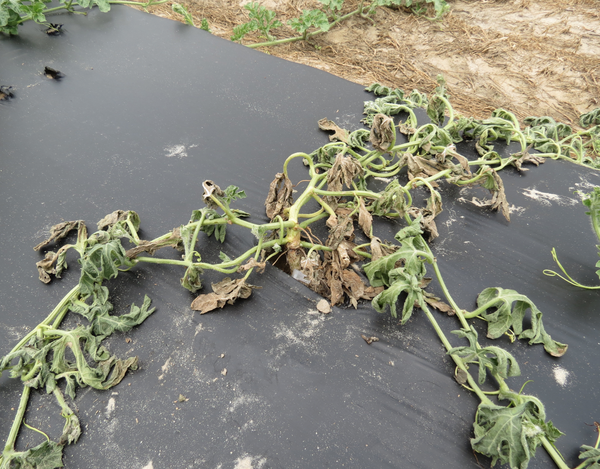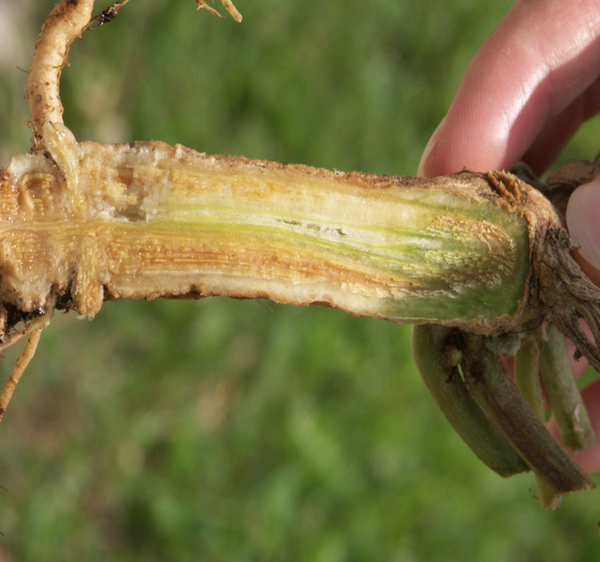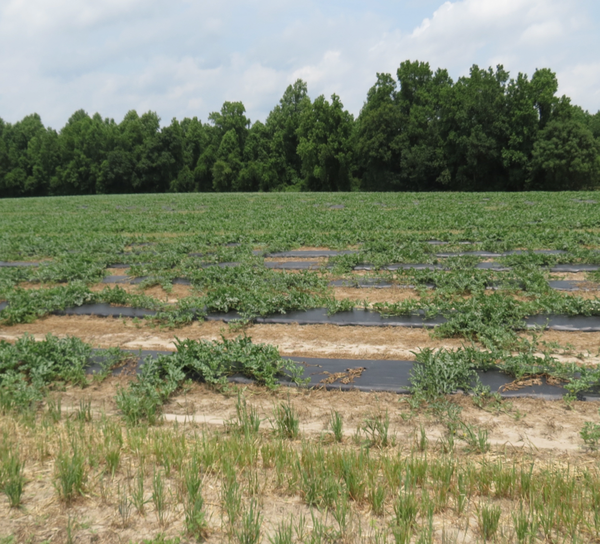Pathogen
Fusarium wilt of watermelon is caused by the fungus Fusarium oxysporum f. sp. niveum (F. oxysporum).
Host Crops and Plants
This disease affects only susceptible watermelon cultivars.
Host Parts Affected
The fungus invades the vascular tissue through the root system, which can cause wilting of the whole plant.
Identification
Fusarium wilt causes wilting of the aboveground tissue and general vine decline. Typically, one side of the plant will exhibit more severe symptoms than the other (Figure 1), which is known as unilateral wilting (Figure 4). The fungus colonizes the vasculature in the root and crown, and cutting open the crown can show brown streaking within the xylem (Figure 2). Fusarium wilt is a patchy disease and will cause disease in plants that appear to be randomly scattered around the field (Figure 3).
Similar Diseases
Verticillium wilt of watermelon, caused by Verticillium dahliae has similar symptoms to Fusarium wilt of watermelon. These two diseases both present unilateral wilting, and cannot be distinguished in the field. Both diseases also cause the same dark brown staining of the vascular tissue. The causal agent must be isolated from the infected tissue to discern which pathogen is causing the disease. Verticillium wilt of watermelon is not common in North Carolina.
Bacterial wilt of cucurbits also exhibits wilting that begins in only a few leaves. This disease is caused by the bacterium Erwinia tracheifila. When the stem is cut, a white bacterial ooze will often come out of the stem, which does not happen in Fusarium wilt.
Favorable Environmental Conditions for the Disease
The disease is favored by cool wet conditions in the spring when infection occurs, but symptoms are observed during the hot and dry conditions in the summer. The pathogen infects in the cool and wet weather when the plants are young and overtakes the vasculature. Hot and dry summer temperatures can stress the plant and cause the wilting symptoms that are typical for the disease.
Disease Transmission
Fusarium oxysporum is a soilborne fungus not transported on air currents. The pathogen can be transported long distances in infected plant tissue, infested soil from transplants, or seed. It is recommended that certified clean seed is utilized in the field. The fungus can create survival spores that will live in the soil for many years (5-10). Flooding in the field can also serve to spread inoculum within a localized area.
General Disease Management
- Plant disease-free seed and transplants.
- Plant resistant varieties of watermelon if the field has a history of Fusarium wilt.
- Rotate crops away from watermelon for 5-10 years if disease is found in the field.
- Use good sanitation practices (removal of infected plant tissue away from the field site, using clean equipment, etc.).
- Plant watermelons in raised beds with plastic mulch.
Disease Control for Conventional Growers
Few fungicides are available for Fusarium wilt control, but a soil application at transplant with prothioconazole (Proline 480 SC) can reduce disease in the field.
For the latest fungicide recommendations for Fusarium wilt of watermelon see the Southeastern US Vegetable Crop Handbook. Fungicide labels are legal documents, always read and follow fungicide labels.
Example products for Fusarium wilt control in watermelon:
| Active ingredient | Example product | Pre-harvest interval (day) | Fungicide group |
|---|---|---|---|
| Prothioconazole | Proline 480 SC | 7 | 3 |
| Pydiflumetofen + fludioxonil | Miravis Prime | 1 | 7 + 12 |
Disease Control for Organic Growers
Organic growers have no chemical control options that are effective and need to completely rely on host resistance and cultural strategies for disease control.
Disease Control for Home Gardeners
Home gardeners have no chemical control options that are effective and need to completely rely on host resistance and cultural strategies for disease control.
Useful Resources
- The NC State Plant Disease and Insect Clinic provides diagnostics and control recommendations
- The NC State Extension Plant Pathology portal provides information on crop disease management
- The Southeastern US Vegetable Crop Handbook provides information on vegetable disease management
- The USDA Fungus-Host Distributions Database provides information about reported hosts for fungal and oomycete pathogens
Acknowledgments
This factsheet was prepared by the NC State Vegetable Pathology Lab in 2015.
Publication date: Aug. 28, 2018
Reviewed/Revised: Jan. 9, 2023
There is an alternate Spanish language version of this document here: Marchitez de Fusarium en sandía
N.C. Cooperative Extension prohibits discrimination and harassment regardless of age, color, disability, family and marital status, gender identity, national origin, political beliefs, race, religion, sex (including pregnancy), sexual orientation and veteran status.




